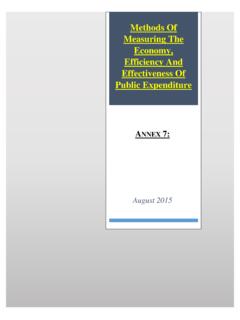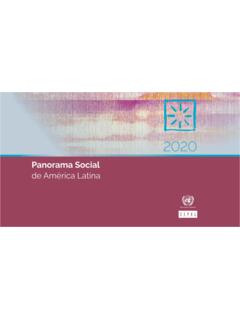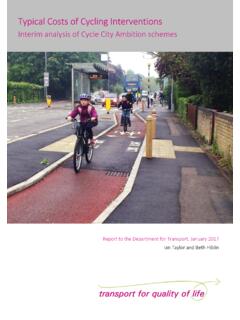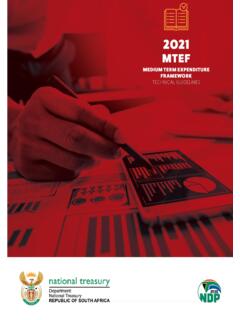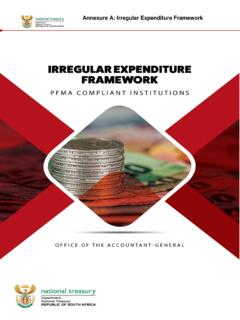Transcription of Revenue and expenditure forecasting techniques for a PER ...
1 Revenue and expenditure forecasting techniques for a PER Spending ANNEX 3: August 2015 TABLE OF CONTENTS 1 Introduction .. 3 The Budgeting Context .. 3 2 The Nature and Process of Revenue forecasting .. 5 What Revenues to Forecast .. 5 What Expenditures to Forecast .. 5 The forecasting Steps .. 7 Step 1: Selection of forecast period .. 7 Step 2: Examination of data for stationarity .. 7 Step 3: Adoption of assumptions .. 7 Step 4: Selection of forecasting methods .. 8 Step 5: Evaluation of estimates .. 8 Step 6: Monitoring of outcome and comparison with forecasts .. 9 Step 7: Updating the Forecasts .. 9 3 The forecasting Methods .. 10 Qualitative and Judgement forecasting Methods .. 10 Quantitative Methods .. 11 Time Series forecasting Basic Concepts .. 12 4 Summary .. 55 LIST OF TABLES Table 3-1: Stata output of Additive Seasonal Model .. 22 Table 3-2: Stata-generated Results with Diagnostics for Equation (51) .. 39 Table 3-3: Illustration of an explanatory regression model.
2 41 Table 3-4: Methods and Indicators used to Forecast Government expenditure .. 49 Table 3-5: Important Taxes and Tax Bases in Partner Countries .. 51 LIST OF FIGURES Figure 3-1: Monthly Data on Crime and Visitor Arrivals in a Caribbean Country .. 14 Figure 3-2: An example of random noise .. 15 Figure 3-3: Data illustrating a random walk .. 15 Figure 3-4: 3-period and 7-period Symmetric Moving Averages .. 18 Figure 3-5: Graphs of Seasonal Effects .. 20 Figure 3-6: Trend and Seasonal Effects Combined .. 20 Figure 3-7: Results of Weighted Moving Average .. 23 Figure 3-8: Comparison of results of exponential smoothing .. 26 Figure 3-9: Local Trends in Data (Panel A, Figure 1) .. 28 Figure 3-10: Comparative results of simple and double exponential smoothing .. 29 Figure 3-11: Holt-Winters and Simple Exponential Smoothing Compared .. 32 Figure 3-12: Residuals for expenditure forecasting Model .. 46 Figure 3-13: In-sample forecast of lgovgdp .. 47 1 Introduction This annex provides a very summary description of a number of methods of forecasting that can be used in a sector PER.
3 forecasting is the use of various applicable analytical methods to project a variable into the future. In this case, our interest is in the revenues available in the future but expenditure can also be forecasted when necessary using some of the same basic methods. Tax Revenue forecasting plays a central role in annual budget formulation. It provides policy makers and fiscal planners with the data needed to guide borrowing, use accumulated reserves, or specify monetary measures to balance the budget. It also informs about what fiscal actions are sustainable and hence how to balance fiscal policy to address the problems in the balance of payments and hence foreign debt. The annex covers (i) the budgeting context; (ii) the nature and process of Revenue forecasting ; the steps in forecasting ; and the forecasting methods. The methods described in this annex are: (i) qualitative forecasting ; (ii) judgement forecasting ; (iii) micro-simulation models; (iv) moving average methods, including ARIMA; (v) exponential smoothing and Holt-Winters methods; (vi) single equation regression forecasting ; and (vii) macroeconometric and GDP-based forecasting models.
4 expenditure forecasting is considered briefly in the Annex when macroeconomic Revenue forecasting is addressed. The forecasting of the expenditure ceiling will be illustrated. The numerical methods of the Annex will be illustrated with Stata code. The note on microsimulation is designed largely for awareness of the existence of a forecasting method that is being increasingly used in Revenue forecasting . In a setting where data are scarce, such as in the partner countries, it will normally be necessary to rely heavily on qualitative and judgemental forecasting . Successful use of these methods in turn relies on the existence of inclusive arrangements for multi-stakeholder participation in budgeting that encourage dialogue and transparent information-sharing. forecasting is a specialist exercise that is prone to error and requires the build-up of expertise over time. Dialogue and information sharing helps to minimize error in the forecasting exercise.
5 The Budgeting Context Sector-specific public expenditure reviews are integral components of the national budget cycle when the purpose of budgeting is to maximize the net outputs and outcomes of government expenditure . Such performance-based budgeting relies on good forecasts of revenues from all sources. It also involves forecasting and prioritizing of the resulting expenditures of all sectors and of the economy as a whole, with particular reference to expenditures on: 1. Infrastructure for social and economic development, including poverty reduction. 2. Social protection services for poverty reduction. forecasting is needed because the start of the process of annual budgeting precedes the actual expenditures of budgeted fund by almost a year. The need applies with greater force to expenditures associated with medium-term and long term planning, which look ahead for 3-5 years.
6 The need for forecasting applies to sector budgeting, local government budgeting, and national budgeting. Further, in the budgeting process, sector-specific forecasts are also needed to ensure that sector budgeting is mutually consistent with budgeting at the level of the local communities and budgeting to meet commitments on internationally-agreed development goals. In all cases, performance-based budgeting requires routine measurement of the economy, efficiency and effectiveness of the expenditures on infrastructure and social services, as part of the process of prioritizing them. There is no commonly-accepted standard method of producing macroeconomic and Revenue forecasts for a sector PER. The PER Team will have to choose from, and give its own weight to, a set of modelling techniques , consumer and business surveys. Apart from microsimulation, the list of methods described in this manual can be treated as a basic set that can be used with the data available to any PER in the partner countries.
7 Important among these is the use of expert opinion and judgement. Fiscal policy in the partner countries must be concerned with improving the consistency of resource allocation within a medium-term fiscal framework that promotes economic development. Thus, the PER should also be guided by a tractable small structural model such as illustrated in Annex 2. Such a model allows focus on long time horizons (greater than a year) rather than business cycles and treats the economy as an evolving For the budget year itself, the PER should supplement this with single structural econometric equations and individual variable forecasts that preserve the underlying consistency of the macroeconomic accounting supply and demand identities. Preservation of the identities allow the forecasts to capture the short-run adjustment of the economy to the long run development path. The identity-preserving model can also be used for what if scenarios, such as are usually reported in the IMF Article IV reports.
8 In this case, the model is shocked and the resulting output compared with a baseline scenario used for budgeting. Use of judgement developed from in-depth analysis of the major sectors of the economy is an important aspect of this effort. This judgement should be developed through dialogue with the business community and other informed stakeholders along with expert opinion and judgement to produce macroeconomic and Revenue forecasts. Indeed, a regular dialogue with the business community can help identify emerging trends in the economy with respect to variables such as investment and exports. Dedicated resources should be allocated to such regular engagement with the business community. In the USA, the results of this dialogue are published as the US Federal Reserve s Beige Book; in the UK, the Bank of England s Agency Report; in Canada, the Bank of Canada s Business Outlook Survey.
9 1 Business cycles are defined as fluctuations or oscillations in economic data that recur periodically, for periods between and 8 years. Periods longer than 8 years are parts of long waves or long trends. The main reference for this view is Burns, A. F., and Mitchell, W. C. (1946). Measuring Business Cycles. New York: National Bureau of Economic Research. 2 The Nature and Process of Revenue forecasting Accurate forecasting of revenues and expenditures is important for avoiding both underfunding and excessive funding of the government, and related consequences of associated surpluses or deficits. forecasting uses available data and methods of analysis to estimate the value of a variable in the future. Here we are concerned with revenues and expenditures. What Revenues to Forecast Revenue forecasting seeks to estimate inflows from the following sources: 1.
10 Tax revenues identified from the taxable capacity of the sectors and aggregated to the national level, including fees, permits, and licences. 2. Sales by sector agencies from productive business activities. 3. Intergovernmental transfers received by the sectors from the national pool. 4. Sector funding from international sources, including earmarked donor support, and other loans and grants. 5. Hidden industrial sector transfers and off-budget funding, whereby the sectors finance activities and institutions that benefit government, such as schools, clinics, libraries, and the like. Revenue forecasts can apply to aggregate total Revenue or to single Revenue sources such as sales tax revenues or property tax revenues. The forecasting methods seek to specify and identify the substantive and numerical relationships between the factors that determine taxable capacity and the amounts of revenues actually collected. 1. The factors that determine the taxable capacity are defined in terms of a.
